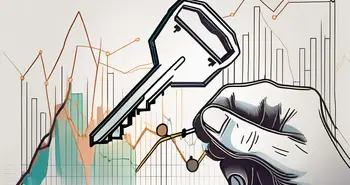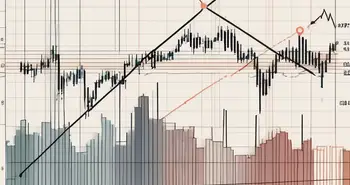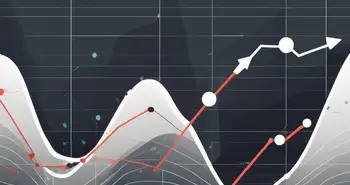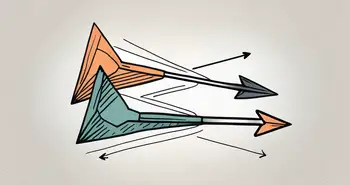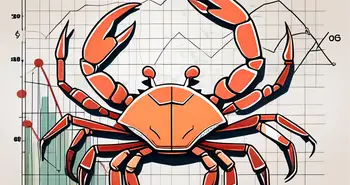Falling Wedge Pattern: How to Spot and Trade
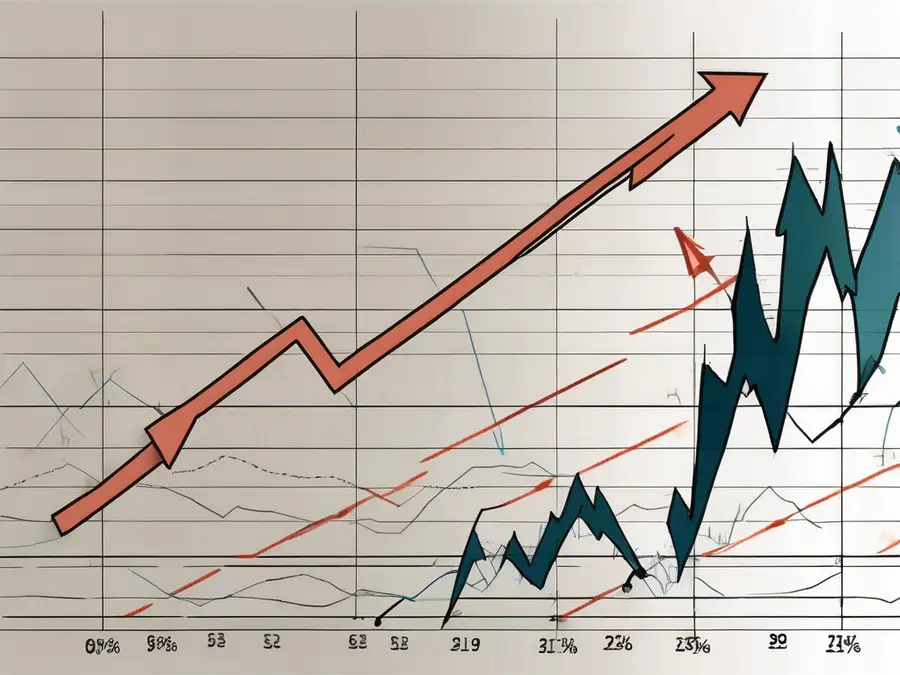
Imagine spotting a pattern that signals a powerful shift in market sentiment, hinting at potential profits just around the corner. After over a decade in the financial markets, I've discovered such a pattern: the falling wedge. This isn't just another chart formation; it's a beacon for traders seeking valuable opportunities in a sea of data. In this article, we'll peel back the layers of the falling wedge pattern, exploring its mechanics, trading strategies, and common misconceptions. Ready to uncover a trading edge? Let’s dive into the fascinating world of the falling wedge pattern and see how it can transform your trading game.
Understanding the Falling Wedge Pattern
The first step in harnessing the power of the falling wedge pattern is to truly understand what it is and its characteristics. In essence, the falling wedge pattern is a bullish continuation pattern that typically occurs during a downtrend. It consists of converging trendlines drawn between lower highs and lower lows, forming a wedge-like shape.
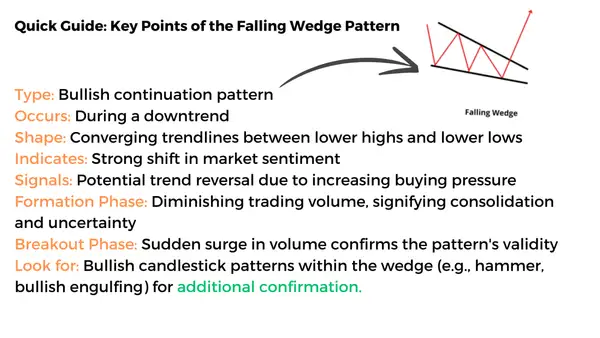 The falling wedge pattern holds immense importance in trading because it represents a strong shift in market sentiment. It indicates that despite the prevailing downtrend, buying pressure is increasing, and a potential trend reversal may be on the horizon.
The falling wedge pattern holds immense importance in trading because it represents a strong shift in market sentiment. It indicates that despite the prevailing downtrend, buying pressure is increasing, and a potential trend reversal may be on the horizon.
When analyzing the falling wedge pattern, it is crucial to pay attention to the volume trends. Typically, during the formation of the falling wedge, the trading volume tends to diminish. This decrease in volume signifies a period of consolidation and uncertainty in the market. However, as the pattern nears completion, a sudden surge in volume often accompanies the breakout, confirming the validity of the pattern.
Traders often look for additional confirmation signals to increase their confidence in the falling wedge pattern. One such signal is the presence of bullish candlestick patterns within the wedge. These candlestick patterns, such as hammer or bullish engulfing patterns, suggest that buyers are stepping in and exerting their influence, further supporting the potential reversal.
It is important to note that the falling wedge pattern is not foolproof and can sometimes result in false breakouts. Therefore, it is crucial to wait for a confirmed breakout above the upper trendline before considering any trading decisions. Additionally, it is advisable to use other technical indicators and tools to complement the analysis of the falling wedge pattern and increase the probability of success.
The Mechanics of the Falling Wedge Pattern
Identifying the falling wedge pattern is crucial for traders looking to capitalize on its potential. One way to spot this pattern is by connecting the swing highs and swing lows with trendlines. As the price continues to converge within this wedge, it creates a compression effect, indicating a possible breakout in the near future.
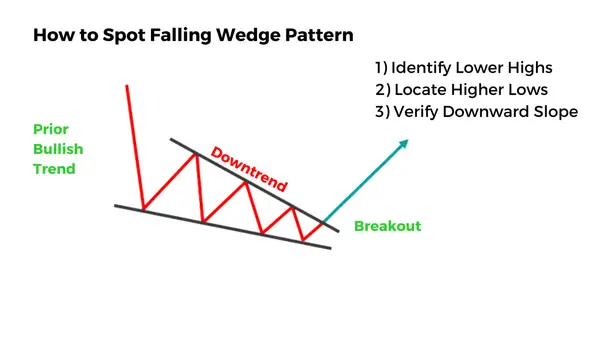
The formation process of the falling wedge pattern is equally important. Typically, you'll notice declining volume during the consolidation phase, and as the pattern nears its apex, volume starts to pick up. This surge in volume is often accompanied by a breakout, signaling the start of a new bullish trend.
The Potential of the Falling Wedge Pattern
The predictive power of the falling wedge pattern is what makes it a favorite among traders. Once the breakout from the wedge occurs, it often leads to a substantial price increase. In fact, many traders consider the target for the breakout move to be the height of the wedge itself. This means that the potential profits from trading the falling wedge pattern can be quite significant.
However, it's worth noting that like any trading strategy, there are risk and reward considerations. While the falling wedge pattern can provide excellent trading opportunities, it's essential to manage your risk and have a clear exit strategy in place to protect your capital.
Strategies for Trading the Falling Wedge Pattern
When it comes to trading the falling wedge pattern, timing is everything. Identifying the optimal entry and exit points can greatly enhance your chances of success. Typically, traders look for a break above the upper trendline as their signal to enter a long position. As for the exit point, many choose to set their target near the height of the wedge or use trailing stop-loss orders to capture maximum profits.
Combining the falling wedge pattern with other indicators can also amplify your trading signals. For instance, keeping an eye on volume indicators can help confirm the strength of the breakout. Additionally, utilizing oscillators such as the Relative Strength Index (RSI) can provide further insights into possible overbought and oversold conditions.
Common Misconceptions About the Falling Wedge Pattern
Despite its effectiveness, the falling wedge pattern has its fair share of misconceptions that can trip up traders. One common mistake is falling for false breakouts. It's essential to wait for a confirmed breakout before entering a trade, as false breaks can quickly lead to losses.
Another critical point to consider is the limitations of the falling wedge pattern. While it does provide valuable insights, it's important to analyze other technical and fundamental factors before making trading decisions. No single pattern or indicator can guarantee success in the markets.
As an expert trader, I always advise aspiring traders to continuously refine their skills and stay updated on market trends. The falling wedge pattern can be a powerful tool, but it's important to develop a holistic trading strategy that incorporates various indicators and risk management techniques.
FAQ
What is the falling wedge pattern?
The falling wedge pattern is a bullish continuation pattern that occurs during a downtrend. It is characterized by converging trendlines drawn between lower highs and lower lows, forming a wedge-like shape.
How do I identify a falling wedge pattern?
To identify a falling wedge pattern, connect the swing highs and swing lows with trendlines. The price should be consolidating within these trendlines, creating a compression effect.
What is the predictive power of the falling wedge pattern?
Once the breakout from the falling wedge pattern occurs, it often leads to a substantial price increase. Many traders consider the target for the breakout move to be the height of the wedge itself.
Can I trade the falling wedge pattern alone?
While the falling wedge pattern can provide excellent trading opportunities, it's important to analyze other technical and fundamental factors before making trading decisions. It's advisable to combine the falling wedge pattern with other indicators for confirmation.
How do I avoid false breakouts when trading the falling wedge pattern?
To avoid false breakouts, it's crucial to wait for a confirmed breakout before entering a trade. False breaks can quickly lead to losses, so staying patient and ensuring confirmation of the breakout is essential.
In conclusion, the falling wedge pattern holds great potential in the world of trading. By understanding its characteristics, mechanics, and strategies for trading it, you can unlock lucrative opportunities in the market. However, it's important to remember that trading involves risk, and no pattern or indicator can guarantee success. Continuously educate yourself, refine your skills, and analyze multiple factors before making trading decisions.
Ready to put the falling wedge pattern into action? Discover the transformative trading experience at Morpher, where the power of blockchain technology meets the world of investing. With zero fees, infinite liquidity, and the ability to trade across a multitude of asset classes, Morpher is the ideal platform for traders who value innovation and flexibility. Whether you're looking to invest fractionally, short sell without interest fees, or leverage your trades up to 10x, Morpher has you covered. Sign up now to take advantage of a unique trading experience and get your free sign-up bonus.

Disclaimer: All investments involve risk, and the past performance of a security, industry, sector, market, financial product, trading strategy, or individual’s trading does not guarantee future results or returns. Investors are fully responsible for any investment decisions they make. Such decisions should be based solely on an evaluation of their financial circumstances, investment objectives, risk tolerance, and liquidity needs. This post does not constitute investment advice.

Painless trading for everyone
Hundreds of markets all in one place - Apple, Bitcoin, Gold, Watches, NFTs, Sneakers and so much more.

Painless trading for everyone
Hundreds of markets all in one place - Apple, Bitcoin, Gold, Watches, NFTs, Sneakers and so much more.


